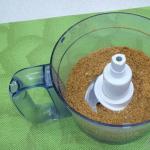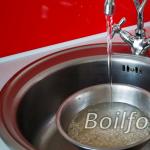Homemade yeast from hops. How to make homemade yeast
How to make yeast at home
Our grandmothers and great-grandmothers made good homemade yeast. They baked bread and made pies.
And how delicious they were with homemade yeast.
Take half a liter of water, add 3 tbsp hops. l and boil over low heat. Strain through a sieve, cool and add one spoonful of honey. Add about half a glass of flour and place in a warm place. If everything was done correctly, the hop yeast should increase in volume. You can store it for a long time as long as mold does not form, so it is better in a closed container, but do not forget to periodically feed the hop yeast with flour so that the yeast does not die
Can be applied to any recipe.
How to make yeast at home?
At home, you can make your own homemade yeast from potatoes, hops, and the easiest way is using live beer.
I used to cook it, but after dry yeast appeared, I also used it.
But what I like most is yeast for baking (as it used to be in blocks) and is now sold in various supermarkets.
Namely - “LUX pressed baker’s yeast”, 100 grams in a pack. Produced in Khimki, Moscow region.
But for sale, stores order a minimum quantity of them, since they have a short shelf life. But I take more of them and store them in the freezer.
It is better to prepare fresh yeast overnight:
1.For 1 glass of rye flour;
2.Take 1 glass of warm boiled water;
Stir and leave for at least 8 hours.
Mix with 1 tablespoon of granulated sugar and 1/2 cup of live beer, put in a warm place for about 3-5 hours.
Use ready-made live yeast for making any pastries and bread / but not in a bread machine /.
If you prepare yeast for future baking, you need to pour it into a plastic bottle and store it in the refrigerator.
But there is one problem here: the refrigerator may not be cold enough for the fermentation process to stop and the bottle to spill out all its contents.
Therefore, it is better to prepare homemade fresh yeast when necessary.
From personal experience, I realized that such yeast is more suitable for making kvass at home - in the summer.
However, in the absence of ready-made yeast, it is quite possible to cook pies with such yeast in the summer at the dacha, having an electric portable oven.
Recipe 1. Yeast for dough at home can be made from flour.
Pour 100 grams of premium wheat flour into a glass, then add raw water to the top of the glass, mix everything thoroughly until a homogeneous mass is obtained.
Place the glass with this substance in a warm place (the temperature should be approximately 35 degrees for 5-6 hours).
When the mass has stood, add four tbsp to it. l. malt wort mixed with a teaspoon of regular live yeast from the store.
After this, leave for a day in a warm place.
Recipe 2. Liquid yeast from potatoes.
Boil half a kilo of peeled potatoes until tender and pass them through a meat grinder with a fine grid.
Mix two glasses of malt wort with a tablespoon of live yeast from the store, diluted in 500 ml of warm water and add to the resulting potato mass.
Mix everything with a mixer or in a blender until smooth and put in a warm place for a day.
Pour the liquid yeast into a glass bottle and seal it tightly, store in the refrigerator.
Yeast is a necessary ingredient in cooking, used in the manufacture of many different products; without yeast it is impossible to prepare some types of bread or beer. The product can always be found in stores or made yourself. It is worth knowing how yeast is made from hops at home, what it is subsequently suitable for, and what it can be replaced with.
Hops are a perennial plant with a long climbing stem covered with thorns. The hop fruit is small cones, which are used to prepare yeast and activate fermentation processes in the production of beer and other similar drinks. The cones are small, when fresh they are bright green in color. Hops have a recognizable fragrant aroma.
Hops contain many resins, various substances that help in the fermentation process and provoke its development, which is why the cones of the plant are so often used in the production of yeast and a number of fermentation-based products. Hops and malt are most often used to make kvass and beer, for mead, but based on such yeast you can also prepare baked goods and some other products.
In addition, hops are used in folk medicine; this plant is generally considered medicinal. Natural, home-made plant-based yeast may have health benefits, among other things. It is also worth considering the main beneficial properties of hops and various products based on it.
Important! However, it is worth remembering that when making yeast at home, you must strictly follow the recipe, otherwise it may turn out to be ineffective.
It is worth considering the basic methods of preparing a hop-based yeast product yourself. In addition to the cones of the plant, other ingredients may be required to make yeast, for example, bran, potatoes. There are many different recipes; you should choose the right one based on its simplicity and the availability of suitable products.
Yeast made at home should not be stored for a long time; it will quickly lose its properties and may eventually even become harmful. The product is usually stored for no more than three months to six months; it should be stored in a gauze bag suspended in a fairly dry, cool place. Before adding yeast anywhere, it should be steamed in hot water.

This recipe is the simplest; yeast obtained in this way can be used to make moonshine, beer drinks, bread, anything. To prepare simple yeast, you don’t need other products, the plant cones themselves are enough.
- Usually they take a small amount of cones, and it does not matter whether they are fresh or dried.
- The cones are poured with hot water, then boiled for an hour.
- The cooled, ready-made broth should be strained well, and the cones and their remains should be removed.
- You need to add sugar and flour to the finished broth; there should be exactly twice as much flour as sugar.
The prepared solution should be placed in a warm place for a couple of days. After two days, you need to grate a couple of boiled potatoes, then the finished puree is added to the solution. This mixture should be kept warm for another day. During this time, the hop yeast will ripen.
From dry hops
Only dry hops are suitable for making yeast using this method.
- First you need to prepare a decoction, as in the previous recipe, after making it you need to cool it only to forty degrees, it should not be very cold.
- Then add a little flour and sugar to it, stir thoroughly so that no lumps form.
Then you need to put the solution in a warm place to infuse; usually the yeast is kept for several days. The finished product can then be used in the preparation of various dishes and drinks.
From hops and bran
In addition to simple hops, you can also use bran. This recipe is more suitable for making kvass.
- To make it, you need to take some fresh, preferably dried, hop cones, then prepare a decoction based on them: the cones should be boiled for an hour over moderate heat.
- After preparation, the broth should be strained and cooled.
- Add one kilogram of flour to the finished broth, mix thoroughly, then, when the mixture has completely cooled, add about a hundred more grams of flour.
- You should use wheat flour; other varieties are not suitable for making yeast.
The prepared solution must be placed in a warm place for 1.5 days for fermentation. After this period has expired, another 200 grams of flour and 300 grams of bran must be added to the solution, after which the yeast is aged for another 4 to 6 hours. The finished mass should be dried, after which it can be used to prepare anything.
Important! It is also worth following a number of rules when making yeast based on hops. In order to be completely satisfied with the finished product, it is advisable to use only glass dishes when preparing; wooden spatulas are also acceptable. Metal utensils may adversely affect the manufacturing process and should not be used.
Also, sometimes whole hop cones are used in recipes, without first making yeast. This method is only suitable for making alcoholic beverages, but in this case it is worth making the yeast first, since this way the hops will be the safest.

In addition, it is worth remembering that sugar speeds up and enhances the fermentation process; sometimes it is added to homemade yeast to speed up its preparation. You should not do this if the recipe does not indicate this; without sufficient experience, there is a possibility of spoiling the finished product. After the expiration date, if the yeast acquires an unpleasant odor or its consistency changes, further use must be abandoned. Spoiled yeast can not only be ineffective, it can harm human health.
Benefits and harms
Hops and completely natural products based on them can be used not only in cooking. A large number of useful substances, various resins, vitamins, essential oils, flavonoids have a positive effect on the body, due to which the plant and its cones can be used as an auxiliary treatment for a number of diseases.
First of all, hops and hop yeast have a positive effect on the condition of the digestive tract. They help normalize the digestion process, promote the proper functioning of the stomach and various parts of the intestines. However, it is worth remembering that the plant has a positive effect on the body only in moderate quantities.
Also, the substances contained in hop yeast products have a calming, sedative effect on the body. In small quantities, they help reduce anxiety, improve sleep quality, and cope with the effects of stress.
Important! In addition, hop yeast extract is used to make various products for external use. In particular, they are used to prepare natural hair restoration products.
Contraindications
It is worth remembering that any substance is useful only to a certain extent, in small, moderate quantities. Usually there are no contraindications to the use of hop yeast; everyone can use it. Strict contraindications include only individual intolerance to the product, for example, if an allergy occurs after using yeast, you should not use it in the future.
Important! Particular care should be taken when using hops in alcoholic beverages.
Otherwise, if you do not abuse hops, especially for medicinal purposes, there are no other contraindications or side effects. The main thing when using this plant and products based on it is a sense of proportion; in excessive quantities it becomes harmful to health.
For home baking, three types of yeast are used - fresh (pressed), dry active and dry quick-acting.
1. Fresh (pressed) yeast is sold in briquettes of 50, 100 or 1000 g. Their main drawback is a very limited shelf life. At room temperature they are stored for no more than a day, in the refrigerator (at a temperature from 0 to +4) - up to 14 days. Therefore, pay special attention to the release date. Fresh yeast has an even pinkish-cream color; when pressed with a finger, the piece should not smear, but crumble. By the way, when storing yeast, you should not pack it tightly - it is a living organism that needs air.
2. Dry active yeast is produced in the form of spherical granules of different diameters. Compared to pressed ones, they are more unpretentious to storage conditions - their shelf life can reach 2 years. To activate such yeast, you need to pour it into a slightly warmed liquid (milk or water) and wait 10-15 minutes until it disperses. Next, active yeast is introduced into the dough in the same way as fresh yeast.
Dry and fresh yeast are completely interchangeable - one teaspoon of dry yeast corresponds to 12 grams of pressed yeast.
There is also liquid yeast, but it is used on an industrial scale in bakeries.
3. Rapid-acting (fast) yeast looks like cylindrical granules. They are very easy to use and do not require pre-activation - such yeast can be added to flour immediately, without pre-soaking. The dough rises quickly and consistently on them.
The Russian word “yeast” goes back to the Proto-Slavic drozgati - “to crush, knead.” The English word "yeast" (yeast) comes from the Old English "gist", "gyst", which means "foam, boil, give off gas."
To keep compressed yeast alive longer, store it at a temperature no higher than 3-4 °C.
To prepare yeast dough for 1 kg of flour, you need from 20 to 50 g of yeast.
The more butter, eggs, sugar you add to the dough, the more yeast you need to add.
Yeast can be replaced with beer or slightly fermented sour cream.
Preparing yeast at home
To prepare yeast at home, dilute a glass of flour with a glass of warm water in a bowl and leave for 5-6 hours. Then pour in a glass of any beer, add a tablespoon of sugar, stir and place in a warm place. When it begins to sparkle, add it to the dough as usual. The dough will turn out very fluffy.
Homemade yeast is made from beer, from hops, from potatoes, from malt, from wheat bran and simply from flour, as well as from rye bread. I give some yeast recipes.
Homegrown yeast from hops.
Pour dry hops (or malt) with double the volume of hot water and boil until the volume of liquid is reduced by half.
Strain the warm broth and for each glass + 1 tbsp. l. sugar and 0.5 tbsp. flour.
Cover the mixture with a cloth and place in a warm place for 1.5-2 days. Then pour the prepared yeast into bottles, seal and keep in a cool place.
Yeast from wheat bran.
1-1.5 kg flour
4 liters of boiling water or hop decoction (4l)
300 bran
Brew 1 kg of flour with boiling water or hop decoction. Cool the brew (it should have a mixture of thick sour cream) to a temperature of 70*, add 100-150 g of flour into it and mix well.
Add another 100-150 g of flour to the brew that has cooled to a temperature of 35* and mix.
Cover with gauze and place in a warm place for 1-1.5 days for fermentation. Then add another 200 g of flour and 300 bran to the mixture, mix and leave to ferment for 6 hours.
Then the mass is rubbed with bran and dried.
Yeast can be used within 3-6 months. Store them in a gauze bag suspended in a cool, dry place.
Before using, soak the yeast in warm water + a little flour, mix and let stand for 40 minutes. Then knead the dough or dough.
Yeast from bran.
Pour 4 tbsp into the pan. wheat bran, pour boiling water so that it barely covers them and a thick porridge forms. While vigorously stirring, add a large handful of bran.
Cover with a napkin and leave for 5 minutes. Add boiling water again and stir + more bran. Cover with a napkin for another 5 minutes. Then + more boiling water until a dough of medium thickness is formed.
Cool, stirring constantly. Drain the water, squeeze out the bran through a napkin.
Pour in 0.5 tbsp. hops (25 g of hops, pour 1 tbsp. boiling water, cover with a saucer, let it brew and strain).
When it cools down + 3-4 tbsp. l. old yeast.
Then pour 1/2 volume into a bottle, seal and place in a dark place for 6 hours.
When the yeast has risen, place the bottles in a cool place.
Such yeast does not store for a long time.
Sour sourdough (used as a leavening agent for bread, butter pies, etc.)
Knead 200 g of flour in water. Make a bun from the risen dough, roll it in flour and let it stand for several days.
During this time, the dough will become sour, dry out and harden.
I will continue the yeast recipes in the next article.
I took the recipes from an old book by Anatoly Andreev. Based on materials from povarenok.ru
More and more housewives are trying to use only natural ingredients when cooking. The most important product on the table - bread - has long become fashionable to bake it yourself so that it turns out fragrant and soft, like a grandmother's in the village. At home, yeast is made from beer, potatoes, hops, malt, rye bread and even raisins.
Yeast from potatoes
2 potatoes 1 teaspoon salt 1 tbsp. sugar 1 tbsp. spoon of water
Grate the potatoes on a fine grater. Add salt, sugar and water. Stir, leave for half a day, after which the yeast will be ready for use.
8 - 12 potatoes 3 cups potato broth 1 tbsp. spoon of flour 1 tbsp. spoon of honey 25 g of vodka
Boil the potatoes, pour the potato broth into a separate container. Wipe the warm potatoes, pour warm potato broth over them, add flour, stir. Then add honey and vodka. Pour the resulting foam into a bottle, let the starter settle and take it out into the cold. After a day, the yeast is ready for use.
Yeast from rye bread
500 g rye bread 0.5 liters of sour milk (yogurt, whey or water) 2 - 3 tbsp. spoons of sugar a handful of raisins
Grind the bread, add sour milk, sugar and raisins. Leave to ferment for a day. Then strain the mixture through a sieve (press the bread on the sieve). Using the resulting infusion, prepare a dough (flour mash) as thick as sour cream. Place in a warm place. The starter used to prepare the dough will be ready in 2-3 hours.
Raisin yeast
100 - 200 g raisin water 2 tbsp. spoons of sugar
Rinse the raisins, put them in a glass bottle, fill them with warm water (so that the raisins have room to float). Add sugar and tie the neck with gauze in four layers, place in a warm place. Fermentation will begin on day 4-5, then you can knock out the yeast (separate it from the main mass) and put the dough.
Yeast from beer
1 glass of flour 1 glass of beer 1 tbsp. spoon sugarwater
Dissolve flour in a glass of warm water and leave for six hours. Then add beer and sugar. Stir and put in a warm place. It is better to store yeast in a tightly closed bottle or jar.
Yeast from malt
1 cup flour ½ cup sugar 5 cups hot water 3 cups malt
Mix flour and sugar with hot water and malt (unfermented). Cook for about an hour over very low heat in a thick-bottomed container, avoiding boiling. Pour the warm solution into bottles, close loosely and place in a warm place for a day, then transfer to a cold place.
Yeast from bread and milk
500 g black bread 1 liter sour milk
Pour milk over the black bread and leave to brew for 24 hours in a warm place. Strain the infusion through a layer of gauze, squeeze and strain again through three layers of gauze. Use the resulting infusion to prepare dough.
Yeast from hops
50 g hop cones 50200 g wheat flour with bran (coarsely ground) 1.5 liters of water 100 - 150 g sugar 250 g mashed potatoes
“You can buy hop cones at the pharmacy, but you should not take hops in bags. Buy a box of grass for 50 or 100 grams, says housewife Svetlana Batsan. - If it is not possible to find the flour specified in the recipe, you can buy wheat and grind the grains in a coffee grinder yourself. You don’t need to add anything to the puree, just boil the potatoes and mash them.”
To prepare the starter, Svetlana recommends using an enamel pan. Pour hops into it and fill it with water. Place over low heat and bring to a boil. After this, cool the broth to the temperature of fresh milk. Strain through cheesecloth.
“The broth should not be hot, this is very important! Add sugar and flour to the strained hop broth. Mix thoroughly with a wooden whisk. Do not use a mixer, work with your hands,” the chef recommends.
After this, put the starter in a warm place for a day. The air temperature should be at least 23 - 24 degrees. If the room is cold, place the starter next to the radiator and cover it with a thick towel.
“It is very important to observe the temperature regime. Plant yeast loves warmth, notes Svetlana. - After a day, add mashed potatoes, it should still be warm, but not hot. Mix everything thoroughly. If there are small lumps of puree left in the starter, it’s okay. Next, put the starter back in a warm place for four days. It is very interesting to watch the fermentation process - first bubbles appear, then foam, and then the starter begins to ferment vigorously. This process is very similar to what happens with kvass. When the foam settles and fermentation stops, the starter is ready. It can be stored in the refrigerator for four months.”
Everyone knows that yeast directly affects the quality of prepared moonshine. Previously, it was not difficult to choose them, because they sold two types: bakery pressed and dry. They were used for all sorts of purposes. But now both the range and consumer requirements have become much wider. Despite the large selection of yeast in the store, real moonshine masters make their own hop yeast.
Among those who distill moonshine, legends about hop yeast have been circulating for many years. By the way, hops belong to the hemp family of plants and contain substances that, like hemp, affect the central nervous system.
In medicine, the plant is used for a sedative effect; it can be found in pharmacies and as part of popular sedatives.
For moonshine brewing, hops perform a number of useful functions:
- improves the quality of mash, cleanses it of harmful substances and reduces fusel;
- makes the mash color lighter if necessary;
- perfectly replaces alcohol or the usual dry yeast when preparing moonshine;
- makes the taste of alcohol soft and pleasant.
High-quality hop yeast will play the role of a good distiller. The plant contains many substances that activate the fermentation process. A homemade recipe for hop yeast for moonshine will help maintain the antioxidant effect and the mash will not sour.
Important! Even with homemade yeast from hops, do not forget about the temperature regime.
Where can I get hops for moonshine?
Having decided to make moonshine with hops, everyone wonders where to get it? You can start collecting plants and get wild hops yourself. It grows almost everywhere where the climate is temperate. But you need to collect cones only in August or September. After this they should be dried thoroughly.
But if you are not a fan of collecting pine cones yourself, then this is not necessary. To make homemade moonshine, you can buy powder, extracts or granulated hops. All this is available both in pharmacies and in regular grocery supermarkets. In addition, specialized stores sell already prepared hop yeast.
Sourdough recipe for hop moonshine
The following recipe will help you make hop yeast using hop pellets. For this you will need:
- 1.5 liters of water at room temperature, divided into portions: 1 l and 0.5 l;
- hops in granules (most often found in pharmacies);
- 200 grams of hot water;
- 100 grams of flour;
- 1 tbsp. l. Sahara.
Having all the ingredients, you can start cooking.
- One liter of water is mixed with granulated pharmaceutical hops.
- The resulting mixture is placed on the stove, brought to a boil and kept on fire for an hour. The water will gradually evaporate and must be added to maintain the same volume.
- The broth should sit for 10–12 hours, then it should be thoroughly squeezed out, and the remaining pulp should be washed with hot water (200 grams). The water is not poured out, but added to the liquid that was filtered.
- Wait until the hops cool down to about 35 degrees, and pour the prepared flour and sugar into it.
- They wait two to three days. Foam will begin to actively form. When this happens, you can safely add leaven to the mash at the rate of four tbsp. l. starter for three liters of mash.
Yeast Making Recipes
To prepare hop yeast, you will need:
- hop cones;
- 0.5 liters of water at room temperature;
- 1 tbsp. l. granulated sugar;
- 150 grams of flour.
- Take a container, put the cones in it and add water. Boil over low heat until 50% has evaporated. Cover everything tightly with a lid and wait eight hours.
- After eight hours, we filter and squeeze out the cake; it is not needed for moonshine brewing.
- Add 200 grams of previously prepared hop brew, sugar and flour to the liquid. Mix until smooth and completely free of lumps. We do not cover this mixture and leave it to brew for two days, at a temperature of 30–35 degrees. When choosing dishes, keep in mind that the starter will double in size.
There is also a recipe for making hop yeast with malt. For this you need:
- 200 grams of hop granules;
- 2 kg flour;
- 1 kg barley malt;
- 12 liters of water.
- The water must be heated to 40 degrees and added to it: malt, hops, flour. Mix thoroughly so that there are no lumps.
- Bring the resulting mass to a boil and simmer over low heat for 60 minutes. We make sure that the volume of water does not change, adding more if necessary.
- We filter. The resulting liquid will be an excellent fermentation catalyst.
Yeast can be called the most important element for starting the fermentation process. In addition, those prepared with hops add useful substances to the product. In this regard, the selection and preparation of yeast must be approached as responsibly as possible. Only by strictly following the recipe can you get a good result.





